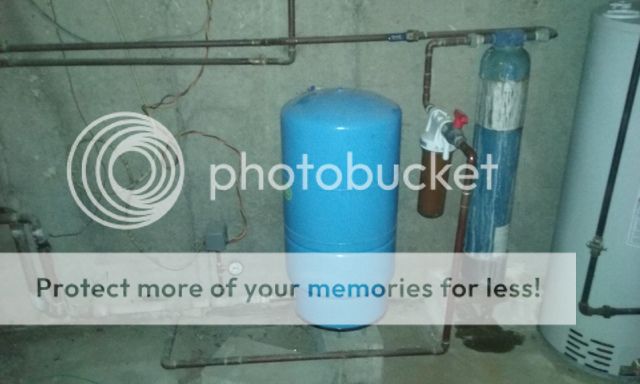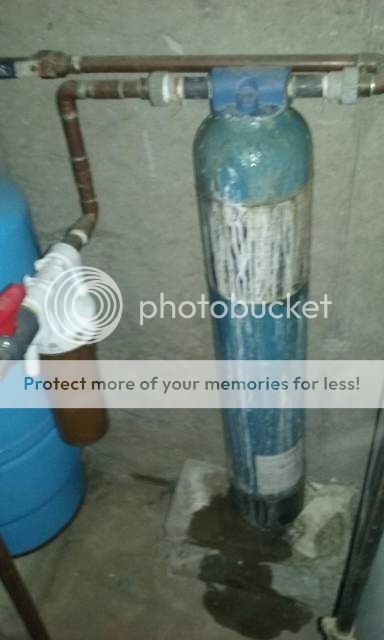First question posted here, so may require some introduction. I can be fairly handy, but am no plumber. My plumbing typically requires multiple trips to the hardware store combined with a few swear words here and there. However, I usually beat and bang my way around with something and finally figure it out. Again, I'm no plumber, but do have a general understanding of how the pump/pressure tank/pressure switch works and I understand head loss in a pipe system.
We bought this home in Montana almost two years ago and have been having low water pressure issues. As in...........if someone is using water for any purpose in the house, you don't want to be taking a shower. Just something as simple as flushing the toilet or filling a glass of water will wipe out the pressure in the shower, or the garden sprinkler, or.......you name it.
As a side note, becasue I know someone will ask...........we knew this problem existed from the inspection report when we bought this house from the bank, but through the closing negotiations this was one of the items that was not part of the deal.
Anyway.......it has steadily gotten a little worse to the point described above and I'm going to have to work on the problem. Watering the newly sodded yard and garden now that summer has gotten here has made the problem stand out even more because we constantly need to run outside and turn the water off. The house has was built in 65 and added onto in 69. There are two full baths (one on the second floor) and one 1/2 bath, 4 bedrooms. We are on a residential well. The pump appears to be working fine same as the low pressure switch. The water bladder tank doesn't look that old and I'm guessing that it's 20 gallons (I have not checked the bladder pressure). The water sample required by the bank before financing indicated the water was good with all numbers within their acceptable range. The well is 35' deep and produces 30 ish gpm if I recall correctly.
Immediately after the water bladder tank there is a filter (clear plastic and about 12" or so deep) that I can change out and have about every other month with a fiber filter that looks like a roll of twine that I buy at Home Depot. It gets a nice rust color to it before being changed so I'm assuming Iron. After the filter I've just described there is a Polyglass Pressure Vessel (approximately 6 to 8" diameter and 36 to 48" tall) that I'm assuming is for some sort of filtration or water softening. There is no date on it at least not that I can read. I can find very limited info online about these other than they are used for filtration/water softening.
Troubleshooting the water bladder tank, pump, and low pressure switch should be simple enough (I did a quick check last year and everything seemed ok). Is it possible that the filter media within this tank is causing some of my pressure problems? Where can I buy a replacement filter for the polyglass pressure vessel? Is this filter really necessary or can I just bypass the thing/remove it? Does a 20 gallon pressure bladder tank seem large enough for a two story house described above? What should the bladder pressure be? What is a standard pressure for the low pressure switch to try to maintain? I think I have the old paperwork for the submersible pump. What size pump would you expect?
We bought this home in Montana almost two years ago and have been having low water pressure issues. As in...........if someone is using water for any purpose in the house, you don't want to be taking a shower. Just something as simple as flushing the toilet or filling a glass of water will wipe out the pressure in the shower, or the garden sprinkler, or.......you name it.
As a side note, becasue I know someone will ask...........we knew this problem existed from the inspection report when we bought this house from the bank, but through the closing negotiations this was one of the items that was not part of the deal.
Anyway.......it has steadily gotten a little worse to the point described above and I'm going to have to work on the problem. Watering the newly sodded yard and garden now that summer has gotten here has made the problem stand out even more because we constantly need to run outside and turn the water off. The house has was built in 65 and added onto in 69. There are two full baths (one on the second floor) and one 1/2 bath, 4 bedrooms. We are on a residential well. The pump appears to be working fine same as the low pressure switch. The water bladder tank doesn't look that old and I'm guessing that it's 20 gallons (I have not checked the bladder pressure). The water sample required by the bank before financing indicated the water was good with all numbers within their acceptable range. The well is 35' deep and produces 30 ish gpm if I recall correctly.
Immediately after the water bladder tank there is a filter (clear plastic and about 12" or so deep) that I can change out and have about every other month with a fiber filter that looks like a roll of twine that I buy at Home Depot. It gets a nice rust color to it before being changed so I'm assuming Iron. After the filter I've just described there is a Polyglass Pressure Vessel (approximately 6 to 8" diameter and 36 to 48" tall) that I'm assuming is for some sort of filtration or water softening. There is no date on it at least not that I can read. I can find very limited info online about these other than they are used for filtration/water softening.
Troubleshooting the water bladder tank, pump, and low pressure switch should be simple enough (I did a quick check last year and everything seemed ok). Is it possible that the filter media within this tank is causing some of my pressure problems? Where can I buy a replacement filter for the polyglass pressure vessel? Is this filter really necessary or can I just bypass the thing/remove it? Does a 20 gallon pressure bladder tank seem large enough for a two story house described above? What should the bladder pressure be? What is a standard pressure for the low pressure switch to try to maintain? I think I have the old paperwork for the submersible pump. What size pump would you expect?


